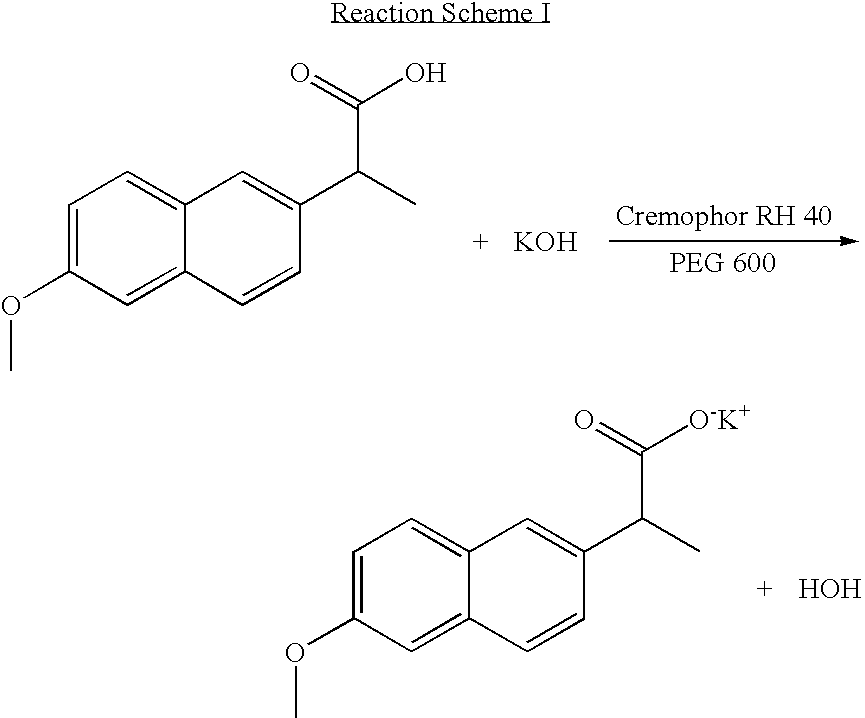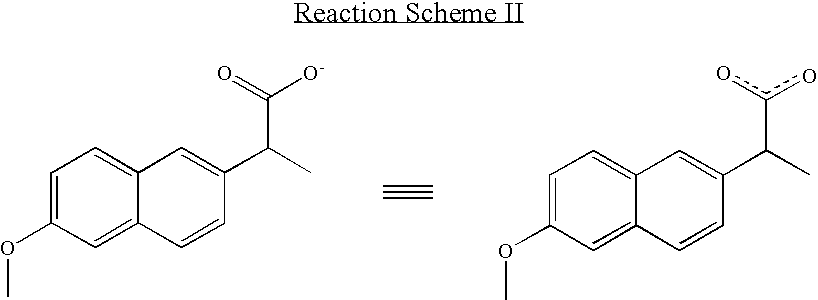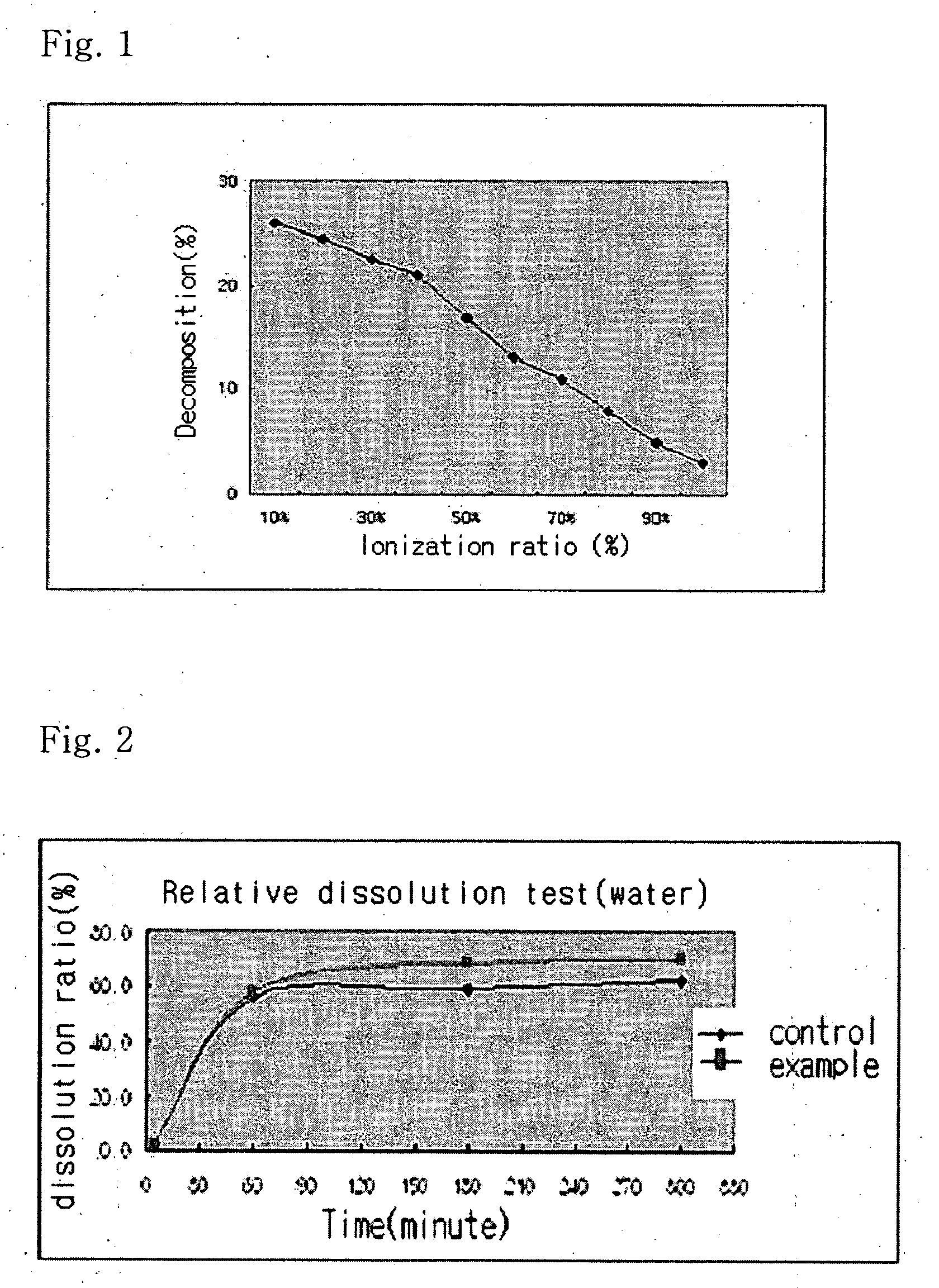Solvent system of hardly soluble drug with improved dissolution rate
a technology of a solution system and a dissolution rate, applied in the field of solvent systems, can solve the problems of not all liquids are suitable as vehicles or carriers, volatile liquids such as water miscible liquids and volatile liquids gelatin plasticizers such as glycerin and propylene glycol cannot be a major component of capsule filling materials, etc., to achieve the effect of improving the solubility of drugs, improving the disintegration and dissolution ra
- Summary
- Abstract
- Description
- Claims
- Application Information
AI Technical Summary
Benefits of technology
Problems solved by technology
Method used
Image
Examples
example 1
Comparison of Solubility in Various Vehicles
[0080] Dexibuprofen and Naproxen which are representative hardly soluble drugs were measured for solubility using the following vehicles and the results are shown in Table 2 below.
2 TABLE 2 Dexibuprofen Naproxen PEG 400 145% 8.1% Tween 80 95% 15.1% Capryol 90 98% 5.1% Labrafil M 2125 CS 45% X Labrasol 88% 19.2% Labrafac CC 44% X Transcutol P 180% 26.7% Cremophor RH 40 86% 18.2%
[0081] The above solubility test for the two drugs were conducted under the same condition (at room temperature). It was shown that Naproxen had a significantly low solubility or was insoluble in the all tested surfactant (X represents "being insoluble").
example 2
Solubility Test of Naproxen
[0082] The solubility of Naproxen was examined using the surfactants described in Table 3 as a subsidiary component (vehicle) for the filling material.
3 TABLE 3 Solubility Solubility Surfactant (%) Surfactant (%) Labrasol 19.2 Lauro glycol FCC 2.5 Cremophor RH 18.2 Lauro glycol 90 3.3 40 Tween 80 15 Transcutol P 26.7 Capryol 90 5 Peceol 4.2 Capryol PGMC 5 Labrafac PG 1.7 Labrafil M X Labrafac CC X 2125 CC Labrafil M X Tri-acetin 5 1944 CS
[0083] As can be seen from the result of Table 3, it was shown that surfactants with excellent solubility, particularly having an HLB (Hydrophilic Lipophilic Balance) value of 5 to 16 are suitable for the solvent system according to the present invention. Also, it was noted that even when the vehicles, i.e. the surfactants were used alone or as a combination, drug release was improved.
example 3
[0084] On the basis of the result of the solubility test in Example 2, pharmaceutical formulations described in Table 4a and Table 4b below were prepared and examined for their properties according to the methods described below. The content of each component was expressed in mg.
4 TABLE 4a Formulation 1 2 3 4 5 6 7 8 9 10 11 Naproxen 250 250 250 250 250 250 250 250 250 250 250 PEG 400 354.5 106.3 PEG 600 260 260 247.6 330.2 330.2 330.2 439.5 240.0 449.9 360 KOH 30.6 35.0 30.6 34.8 34.8 34.8 34.8 35.1 35.05 35.05 35.05 R.O. water 61.3 35.0 61.3 61.3 61.3 61.3 61.3 35.5 35.05 35.05 35.05 Transcutol P 23.7 Glycerin 17.4 10 Labrafac cc 23.7 20.0 Labrafac PG 20.0 Tween 80 23.7240 30 120 Total 619.3 590 696.4 700 700 700 700 800.1 800.1 800 800.1
[0085]
5 TABLE 4b Formulation 12 13 14 15 16 17 18 19 20 21 22 Naproxen 250 250 250 250 250 250 250 250 250 250 250 PEG 600 420 382.9 369.9 369.9 360 360 390 360 454.3 Cremophor RH4050 KOH 35.05 35.05 35.05 35.05 35.05 35.05 35.05 35.05 35 R.O Wate...
PUM
| Property | Measurement | Unit |
|---|---|---|
| pH | aaaaa | aaaaa |
| adhesion temperature | aaaaa | aaaaa |
| adhesion temperature | aaaaa | aaaaa |
Abstract
Description
Claims
Application Information
 Login to View More
Login to View More - R&D
- Intellectual Property
- Life Sciences
- Materials
- Tech Scout
- Unparalleled Data Quality
- Higher Quality Content
- 60% Fewer Hallucinations
Browse by: Latest US Patents, China's latest patents, Technical Efficacy Thesaurus, Application Domain, Technology Topic, Popular Technical Reports.
© 2025 PatSnap. All rights reserved.Legal|Privacy policy|Modern Slavery Act Transparency Statement|Sitemap|About US| Contact US: help@patsnap.com



